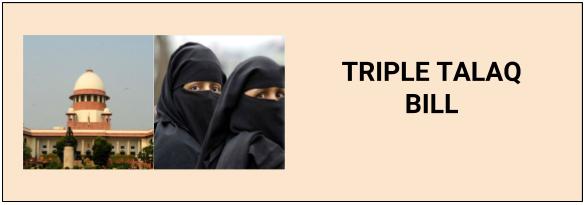
::TRIPLE TALAQ BILL::
The Supreme Court in the matter of Shayara Bano Vs. Union of India and others
and other connected matters, on 22nd August, 2017, in a majority judgement of
3:2, set aside the practice of talaq-e-biddat (three pronouncements of talaq, at
one and the same time) practiced by certain Muslim husbands to divorce their
wives. This judgement gave a boost to liberate Indian Muslim women from the
age-old practice of capricious and whimsical method of divorce, by some Muslim
men, leaving no room for reconciliation. The petitioner in the above said case
challenged, inter alia, talaq-e-biddat on the ground that the said practice is
discriminatory and against dignity of women. The judgement vindicated the
position taken by the Government that talaq-e-biddat is against constitutional
morality, dignity of women and the principles of gender equality, as also
against gender equity guaranteed under the Constitution.
The All India Muslim Personal Law Board (AIMPLB), which was the 7th
respondent in the above case, in their affidavit, inter alia, contended that it
was not for the judiciary to decide matters of religious practices such as
talaq-e-biddat, but for the legislature to make any law on the same. They had
also submitted in the Supreme Court that they would issue advisories to the
members of the community against this practice.
In spite of the Supreme Court setting aside talaq-e-biddat, and the assurance
of AIMPLB, there have been reports of divorce by way of talaq-e-biddat from
different parts of the country. It is seen that setting aside talaq-e-biddat by
the Supreme Court has not worked as any deterrent in bringing down the number of
divorces by this practice among certain Muslims. It is, therefore, felt that
there is a need for State action to give effect to the order of the Supreme
Court and to redress the grievances of victims of illegal divorce.
In order to prevent the continued harassment being meted out to the hapless
married Muslim women due to talaq-e-biddat, urgent suitable legislation is
necessary to give some relief to them. The Bill proposes to declare
pronouncement of talaq-e-biddat by Muslim husbands void and illegal in view of
the Supreme Court verdict. Further, the illegal act of pronouncing
talaq-e-biddat shall be a punishable offence. This is essential to prevent this
form of divorce, wherein the wife does not have any say in severing the marital
relationship. It is also proposed to provide for matters such as subsistence
allowance from the husband for the livelihood and daily supporting needs of the
wife, in the event of husband pronouncing talaq-e-biddat, and, also of the
dependent children. The wife would also be entitled to custody of minor
children.
The legislation would help in ensuring the larger Constitutional goals of
gender justice and gender equality of married Muslim women and help subserve
their fundamental rights of non-discrimination and empowerment.